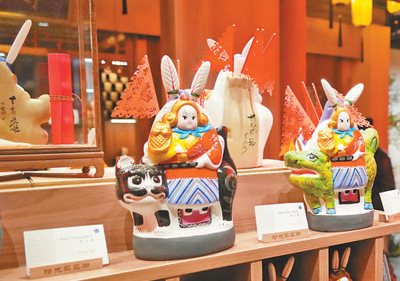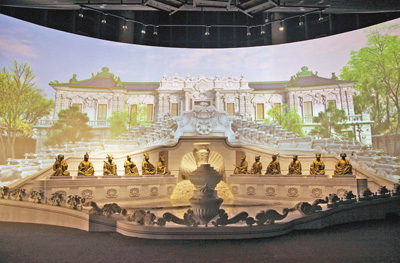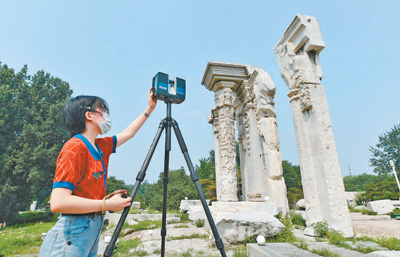Glory of China’s Yuanmingyuan restored through application of digital technologies
Starting from 2009, Yuanmingyuan Park in Beijing, together with scholars and experts, began working towards replicating the park using digital technology, bringing the park back to life virtually.
Yuanmingyuan (also known as the Old Summer Palace) used to be the most splendid royal garden in all of China, and is regarded as the "Garden of Gardens" in the country. It is renowned for its extensive collection of garden landscapes and built architecture. The construction of the park began in 1707, and repeated expansions continued over the next 150 years. In 1860, the royal palace and accompanying sites were burned down to the ground by invading British and French troops.

Photo shows cultural and creative products being sold inside a shop along a street for vendors in Yuanmingyuan Park. (Photo/Cui Nan)
So far, 108 scenic sites inside the park have been digitally rendered, among which two thirds of all the sites have been precisely replicated. Besides, the digital rebirth of the park’s scenic spots, including Changchunyuan, or the Garden of Eternal Spring, and another two gardens, altogether with 629 pieces of information, 520 restored maps and 19 videos, has been reproduced virtually for inclusion in the park’s online tour guide system.
In addition, a virtual field archaeology system was launched on June 11, which allows people to learn about the history and culture of China’s renowned imperial gardens, as well as visiting some of its sites with the assistance of digital technology, such as virtual panoramic roaming technology and 3D photorealistic modeling.
“The system is a combination of virtual reality and entertainment, and is appealing to young people,” said Zhang Jianwei, deputy dean of the School of Archaeology and Museology of Peking University. He added that the system will integrate archaeology in a virtual environment with archaeological excavation in the future and will be applied for the teaching of archaeology.
Collecting and recording all kinds of data on cultural relics is also an important step in those efforts aimed at their preservation and restoration. To better record the minutiae of details on China’s many cultural relics, 3D scanners, which boast a high resolution, have been applied to produce permanent digital archives on such sites.

Photo shows the digitalized version of “Haiyan Tang” (Calm Sea Hall) located inside Yuanmingyuan Park. (Photo courtesy of Beijing Tsinghua Heritage Institute for Digitization)
“Cultural relics have a life cycle, too. Open-air stone cultural relics, in particular, are subject to damage due to exposure to sunlight and wind,” said a staff member from Yuanmingyuan Park’s management office. In recent years, the park and Peking University have worked together on the archival digitalization of stone cultural relics by applying 3D scanning, photogrammetry and panoramic photography technologies, among other advanced approaches, having accumulated a whopping two terabytes of data.
Yuanmingyuan Park has continuously collected digital images of the various treasures that have been restored and are housed inside the park, along with those items returned from other countries, with all of this detailed data having been saved in big databases. This has enabled the general public to appreciate the park’s prized cultural heritage online. At present, the digital versions for 118 cultural relics, including porcelains, jade and bronze wares, and stone carving artworks are on display on Yuanmingyuan Park’s official WeChat account.
In 2016, the digital restoration project received the approval of the Ministry of Science and Technology. The ministry praised the program highly for “blazing a brand new path for showcasing and exploiting 330,000 ancient ruins and tombs in China.”
In 2013, the park joined hands with Tsinghua University and undertook a national-level program that integrated digital technology and tourism. Experts from different fields, such as architecture, history, computer science, archaeology, and surveying were invited to develop new tourism products and experiences.
Thanks to new technologies, such as virtual reality, augmented reality, and mixed reality, the general public can get much closer to the simulated reality offered through the unveiling of digital restoration projects like the one being undertaken at Yuanmingyuan Park, in this way gaining a better understanding of China’s age-old culture and history.

A worker collects data on cultural relics inside Yuanmingyuan Park. (Photo/Yuan Yi)
Digital exhibitions featuring the park have meanwhile been held in different parts of the country, reaching an even wider swath of the domestic viewing public. The five exhibitions held at the Museum of Chinese Gardens and Landscape Architecture in Beijing since 2016 have attracted over 400,000 visitors. During one exhibition held in Zhengzhou, capital of central China's Henan Province, the process for the digital rebirth of “Haiyan Tang” (or Calm Sea Hall) was presented on a 7-meter-high cyclorama. Some members of the viewing public, after visiting an exhibition held in Beijing’s Shougang Park in July 2020, said they were awed by its mixing up of history and technology, while others commented that “only when a country becomes strong can its history and culture be better protected.”
“With the upgrading of technology, the park will be presented to the public in more diverse ways,” said Qiu Wenzhong, head of the management office for the park in the capital’s Haidian district, adding that the combination of culture and technology will give visitors a feast for their eyes.
Photos
Related Stories
- Yuanmingyuan Ruins Park opens for free on its 161st anniversary of destruction
- Entrance of Changchun Garden in Summer Palace opens to tourists
- Old photos of Yuanmingyuan a hit online
- Online broadcast of Yuanmingyuan archaeological excavation made over social media
- Parts of Old Summer Palace replica to be open in May amid controversy
- More than 100 relics from Yuanmingyuan displayed
- Delicate lotus in Yuanmingyuan Park
- Freeloading seniors dig up palace
- What a pity! Looted imperial jade seals from Old Summer Palace (8)
- What a pity! Looted imperial jade seals from Old Summer Palace (7)
Copyright © 2022 People's Daily Online. All Rights Reserved.









